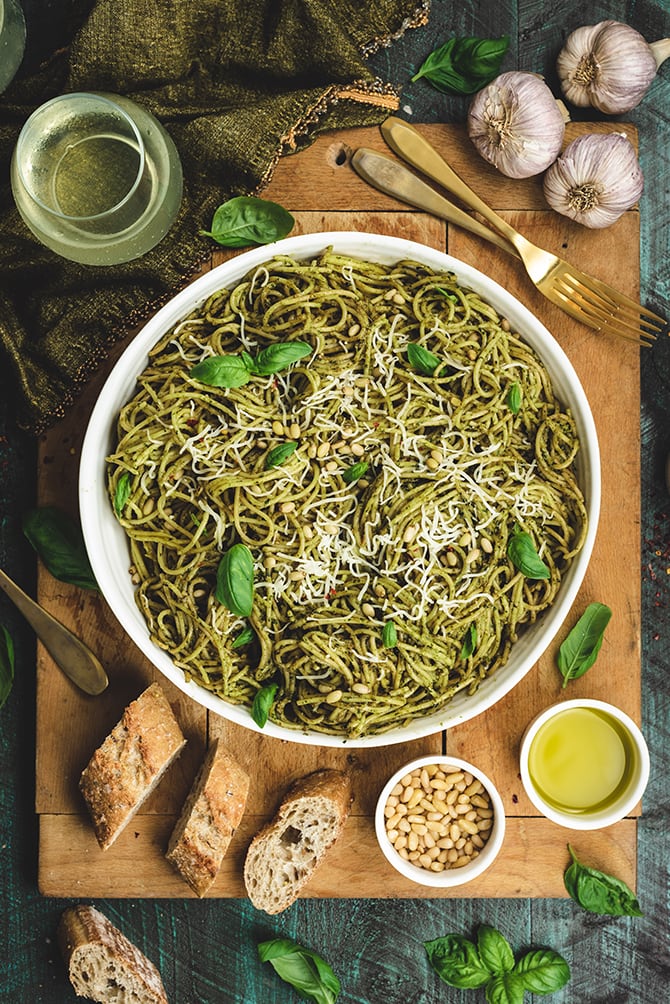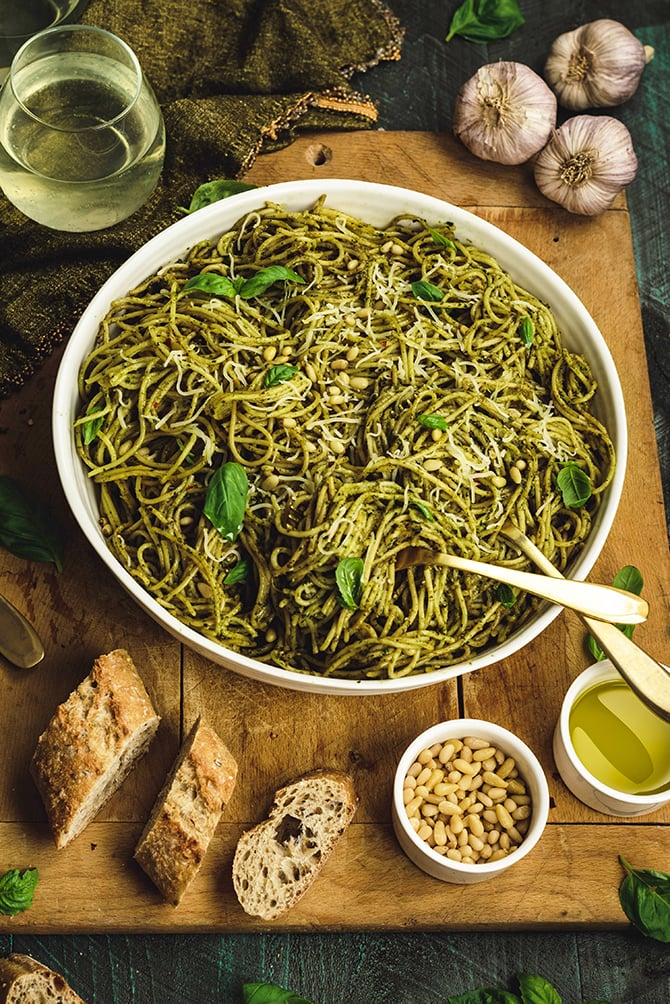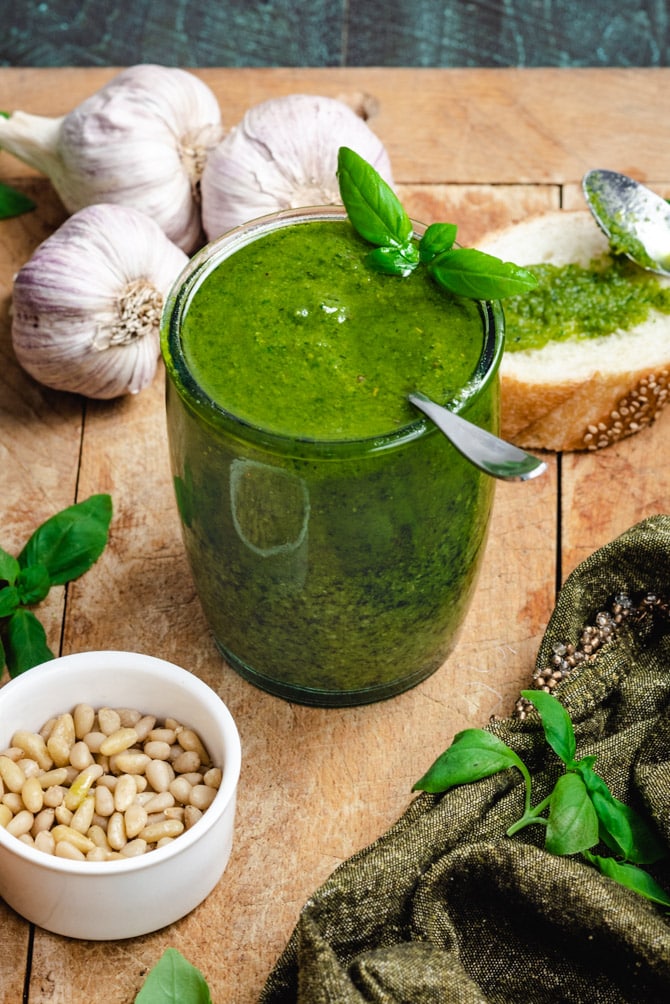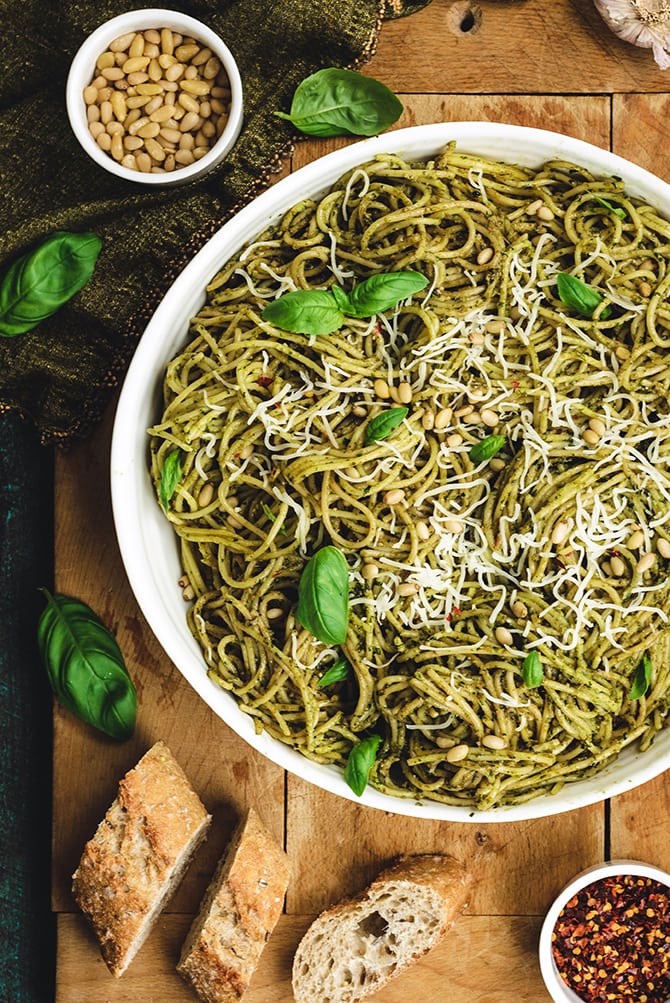How to Use Pesto Sauce in a Jar
Pesto Pasta is one of those restaurant-worthy recipes that couldn't be faster or easier to whip up at home. But it also takes a tiny bit of know-how to do it the right way. Learn how to get the perfect coating of pesto to cling to your pasta without resorting to excessive amounts of oil or a separated sauce. The secret to perfect Pesto Pasta is simpler than you'd think!

A few weeks back, I shared my go-to recipe for Basil Pesto.
Since then, I haven't stopped making it. In fact, I think I've gone into pesto overdrive mode, trying to use up the last of my basil bush before the cold weather destroys what's left of it. Hold out just a little while longer, cold Autumn nights and pumpkin spice. I'm not quite ready for you yet.
You know what, I think people usually think of pesto as a sort of spring and summertime thing, but the truth is that you can and should make it year-round. Fresh basil pesto never goes out of style, and indoor herb gardens will keep your basil all the way through the winter monthss. Or, hey, you can always just grab some from the grocery store.
I've come up with about a thousand creative ways to use up my mason jars of pesto, but I keep going back to good old fashioned, silky pesto-slicked pasta. Not only is it the most common way to use up a jar of the green stuff, but it's also one of the simplest. It ticks all the boxes.
Easy to make? Check.
Fast enough for a weeknight dinner? Check.
Delicious? Check, check, check.

This is the kind of meal you make when you want to eat something that tastes fancy but lets you autopilot your way through the kitchen to whip it together. And let me tell you, it does taste fancy. It's bright, bold, and fresh-flavored, but still satisfying enough to quench your carb cravings.
If I'm being honest, I double down on the carbs and serve it with crusty bread to mop up any excess pesto. Make that lots of crusty bread. Mmm.
HOW TO MAKE PESTO PASTA
I've already gone on and on about how this recipe is easy to make, but let's actually break it down here so you can see just how quickly it comes together. Here's everything you need to do:
- Secure some pesto. Throw together some of my go-to homemade Basil Pesto (Pesto Alla Genovese) in your food processor or blender, or if you want to cheat a bit, as Ina would say, store-bought is fine. Really though, make the pesto yourself if you have an extra few minutes. It's like 75% of the work for this recipe and 750% worth it.
- Cook the pasta. Boil a large pot of salted water and add your pasta. Cook to al dente.
- Don't drain all that water!You might usually strain your pasta, but this time, instead of draining the pasta the normal way, consider using tongs to transfer it to your colander or a large bowl. This way, you'll be able to save the starchy pasta water. More about that in a minute.
- Mix everything together. Toss your pasta, pesto, and pasta water in a large bowl until evenly coated and smooth. Give it a taste and season with additional salt and pepper if needed.
- Top it off.Top your pasta with parmesan cheese, pine nuts, red pepper flakes, and a few fresh basil leaves, to garnish.

WHY SAVE THE PASTA WATER?
The key to making smooth pesto sauce for your pasta lies in mixing in that pasta water! It might be murky-looking, but pasta water is called "liquid gold" for a reason.
Here's why it works: As you might expect, as the pasta boils, it sheds starches into the water surrounding it.This is why the water winds up a golden color! Those starches serve as thickeners and emulsifiers. It's sort of like how adding flour or cornstarch will thicken a gravy and prevent it from separating, for example!
So when the pasta water is added to an oily base (like the rendered fat from a pan-fried chicken thigh, or in this case, the olive oil-packed pesto) the resulting sauce will be smooth, stable, and will cling to the pasta instead of sliding off when you lift your fork.
Keep that tip in your back pocket because it works for all sorts of sauces!

JAZZ IT UP
Anyone who has been following along here for a while knows that the one thing I love as even more than a great recipe is a versatile one. (Or, I guess I should say agreat versatile one.)
The thing is, there is a 100% likelihood that– at any point in time– there is somethinglurking in the depths of my fridge that I forgot about and that needs to be used up ASAP. Broccoli hiding in the bottom of the vegetable drawer, leftover grilled chicken in a plastic container that got pushed to the back of the shelf; you know how it is.
Let's use that stuff up!
Here are my favorite ingredients and twists on my base pesto pasta recipe to make it even more exciting:
- Go green.As a rule of thumb, if it's green, it probably will taste good with pesto. Asparagus? Yup. Broccoli? Yup. Kale? Spinach? Arugula? Yup, yup, yup. Even avocado is great when mashed with the pesto sauce and some lemon juice to create a creamier pesto "dressing". When using veggies like broccoli, be sure to blanch or saute them first so they're cooked enough to eat but still crisp. If using leafy greens that you could eat raw (like spinach), simply mix them in with your warm pasta after you've removed it from the pasta water so the leafy green wilt but don't totally soften.
- Or you can use buttermilk!If your curiosity was piqued when I mentioned creamy avocado pesto dressing, you might also enjoy the buttermilk pesto dressing I use on my Creamy Pesto Pasta Salad. (Or maybe you'd like the entire recipe!)
- Get creative with your pesto.Sure, my go-to is basil pesto, but you can use other leafy greens like the ones mentioned above (kale, spinach, or argula) instead. You can also swap out the pine nuts for walnuts or even sunflower seeds, or add in extra ingredients like sun-dried tomatoes or roasted red peppers!
- No pasta? No problem. If you can't (or don't want to) use pasta, that's alright! Shredded spaghetti squash or rice make great alternatives.
- Go crazy with the mix-ins.Other mix-in options include capers, peppers, cherry tomatoes, mozzarella, lean meats like chicken or fish, and more!
If you have other ideas, let me know in the comments!
"HOW TO MAKE PESTO PASTA" VIDEO
- 1 cup basil pesto, homemade or store-bought, plus more as needed
- 12 ounces pasta of choice
- Kosher salt and black pepper, to taste
- Freshly shredded parmesan cheese, to serve
- Pine nuts, to serve
- Fresh basil leaves, to serve
- Crushed red pepper flakes, to serve, optional
- Bring a large pot of heavily salted water to a boil. Cook the pasta to al dente. Remove the pasta from the pot using tongs, and reserve the pasta water.
- Transfer the pasta to a large bowl. Add 1 cup of pesto and 1/4 cup of the pasta water. Toss to combine and add additional pasta water as needed to fully coat the pasta in glossy pesto sauce.
- Season with additional salt and pepper to taste. Top with parmesan cheese, pine nuts, basil leaves, and crushed red pepper flakes, if desired. Serve warm or cold.

How to Use Pesto Sauce in a Jar
Source: https://hostthetoast.com/pesto-pasta/